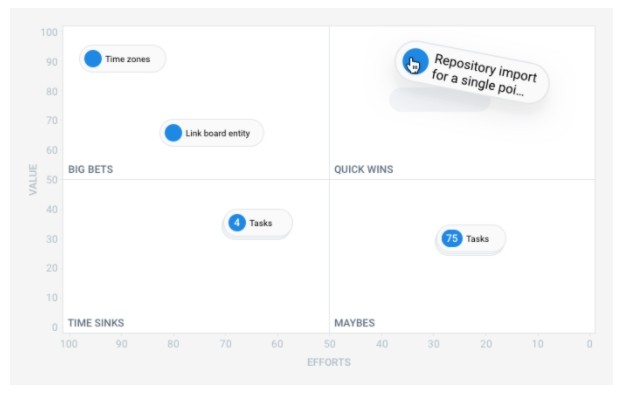Why and how to conduct backlog grooming in grocery teams?
Baclog grocery tasks is one of the main and mandatory artifacts of Agile. In fact, this is a set of requirements received from a business and formulated as tasks for development. What needs to be done to ensure that these tasks are always in order? And how does this relate to the concept of backlog grooming?

A set of such tasks carries no value if it does not bring systemic or structural optimization. It is very important to be able to manage the task queue correctly in order to get relevant material for work. This is precisely the goal of such a process or activity as a backlog of grooming.
Backlog grooming is a meeting of representatives of the Scrum-team, during which the details of the backlog of the product are discussed and the next sprint planning is being prepared.
')
Surely, most managers and owners of products, thanks to their experience and practice, know how to turn routine backlog management into a pleasant process . To achieve this, you must carefully care for the backlog, “clean” and optimize it. This is what is called grooming or product backlog refinement.
You must admit that any product, like a person, requires attention and care.

Since backlog is a queue of user stories, then, often, such a list can quickly become overloaded. Many do not know how to cope with such an overload, and the backlog continues to grow.
When this happens, team members may lose focus on important tasks, and the status of user stories may lose clarity. There may also be problems with estimating time and resources.
Backing care is an activity involving a project manager (product manager / product owner) and a client representative, aimed at breaking backing up into user histories, reorienting them and setting new priorities. Backlog grooming in product management should be a permanent event based on in-depth analysis and clear action.
This process is necessary to ensure that the tasks presented in the backlog are relevant, and those presented at the top of the list are ready for sprint planning, implementation and release.

Backlog grooming is often called pre-planning. Usually the owner of the product and representatives of the team will organize it in the middle of the sprint.
The process is not considered a formal part of Scrum. However, it is recommended that the product owner and team representatives allocate up to 15% of each sprint for such activity.
Sometimes a backlog grooming meeting is called story time session. In any case, the purpose of this event is to discuss the current backlog, determine and propose actions for its optimization. This may include the following:
Typically, grooming helps ensure that the requirements will be refined, and user stories will be prepared to work in advance of the sprint planning.
When planning future interactions, the team will have a clearly defined set of stories and tasks that will be broken down into independent components, assessed and prioritized.
The results of grooming is a healthy backlog:
Since the definition of priorities is a key point during the backlog grooming, it is very important to correctly visualize the importance and interrelation of tasks for further work with them. For ordering ideas and tasks, product managers use the Value and Efforts parameters. Comparing these values for each task helps to better prioritize and select the most important tasks.
In Hygger.io, the Backlog Priority Chart chart is used to visualize backlog tasks and determine their priorities. With it, it is easy to understand when the backlog becomes too large.

It is important to remember that grooming should be a permanent event in the management of a product that should not be neglected. This process is the norm for quality product development. The most important thing in it is to optimize backlog tasks for subsequent work with them.
Backlog grooming helps clarify the relevance of tasks presented in the backlog, analyze existing issues and get additional information about tasks that are not yet completely clear.
Summing up, we note the main advantages of backlog grooming:

A set of such tasks carries no value if it does not bring systemic or structural optimization. It is very important to be able to manage the task queue correctly in order to get relevant material for work. This is precisely the goal of such a process or activity as a backlog of grooming.
Another type of meeting in Scrum
Backlog grooming is a meeting of representatives of the Scrum-team, during which the details of the backlog of the product are discussed and the next sprint planning is being prepared.
')
Surely, most managers and owners of products, thanks to their experience and practice, know how to turn routine backlog management into a pleasant process . To achieve this, you must carefully care for the backlog, “clean” and optimize it. This is what is called grooming or product backlog refinement.
You must admit that any product, like a person, requires attention and care.

Strategic sense of grooming in product management
Since backlog is a queue of user stories, then, often, such a list can quickly become overloaded. Many do not know how to cope with such an overload, and the backlog continues to grow.
When this happens, team members may lose focus on important tasks, and the status of user stories may lose clarity. There may also be problems with estimating time and resources.
Backing care is an activity involving a project manager (product manager / product owner) and a client representative, aimed at breaking backing up into user histories, reorienting them and setting new priorities. Backlog grooming in product management should be a permanent event based on in-depth analysis and clear action.
This process is necessary to ensure that the tasks presented in the backlog are relevant, and those presented at the top of the list are ready for sprint planning, implementation and release.

Backlog grooming is often called pre-planning. Usually the owner of the product and representatives of the team will organize it in the middle of the sprint.
The process is not considered a formal part of Scrum. However, it is recommended that the product owner and team representatives allocate up to 15% of each sprint for such activity.
The main goals of the backlog grooming process
Sometimes a backlog grooming meeting is called story time session. In any case, the purpose of this event is to discuss the current backlog, determine and propose actions for its optimization. This may include the following:
- Writing new user stories
- Deleting irrelevant user stories
- Re-prioritization of tasks
- Adding new features, setting priorities and evaluating them
- Improving and changing the priorities of previously described user stories
- Breaking down some user stories into smaller ones
- Revision of testing criteria
- Analysis of time and individual assessments for individual backlog issues
- Adjustment of estimates in the light of new data, etc.
Typically, grooming helps ensure that the requirements will be refined, and user stories will be prepared to work in advance of the sprint planning.
When planning future interactions, the team will have a clearly defined set of stories and tasks that will be broken down into independent components, assessed and prioritized.
Good grooming result
The results of grooming is a healthy backlog:
- When the tasks at the top of the backlog are enough for 2-3 sprints
- User stories are clear to all team members.
- Stories rated by team
- User stories have a size that allows you to implement several of them in one sprint
What tools to use for backlog grooming?
Since the definition of priorities is a key point during the backlog grooming, it is very important to correctly visualize the importance and interrelation of tasks for further work with them. For ordering ideas and tasks, product managers use the Value and Efforts parameters. Comparing these values for each task helps to better prioritize and select the most important tasks.
- Valuation Value shows what business value a product can bring.
- Efforts measure the resources needed to complete a task.
In Hygger.io, the Backlog Priority Chart chart is used to visualize backlog tasks and determine their priorities. With it, it is easy to understand when the backlog becomes too large.

As a conclusion
It is important to remember that grooming should be a permanent event in the management of a product that should not be neglected. This process is the norm for quality product development. The most important thing in it is to optimize backlog tasks for subsequent work with them.
Backlog grooming helps clarify the relevance of tasks presented in the backlog, analyze existing issues and get additional information about tasks that are not yet completely clear.
Summing up, we note the main advantages of backlog grooming:
- Eliminates uncertainty and unknown facts in user stories, which undoubtedly increase the effectiveness of the product.
- Helps to avoid "alterations" in the development and testing.
- Identifies dependencies in a team and helps predict risks.
- Constant grooming saves the development team time for further discussion during the sprint cycle because it provides clarity to developers and testers.
- Successful grooming leads to effective sprint planning.
Source: https://habr.com/ru/post/354378/
All Articles